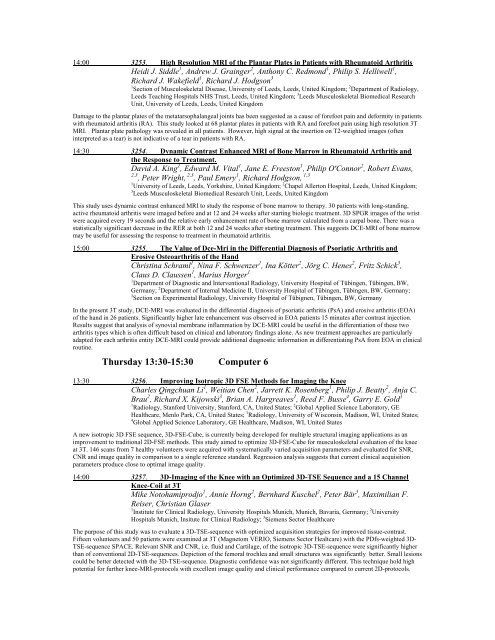ELECTRONIC POSTER - ismrm
ELECTRONIC POSTER - ismrm
ELECTRONIC POSTER - ismrm
Create successful ePaper yourself
Turn your PDF publications into a flip-book with our unique Google optimized e-Paper software.
14:00 3253. High Resolution MRI of the Plantar Plates in Patients with Rheumatoid Arthritis<br />
Heidi J. Siddle 1 , Andrew J. Grainger 2 , Anthony C. Redmond 1 , Philip S. Helliwell 1 ,<br />
Richard J. Wakefield 1 , Richard J. Hodgson 3<br />
1 Section of Musculoskeletal Disease, University of Leeds, Leeds, United Kingdom; 2 Department of Radiology,<br />
Leeds Teaching Hospitals NHS Trust, Leeds, United Kingdom; 3 Leeds Musculoskeletal Biomedical Research<br />
Unit, University of Leeds, Leeds, United Kingdom<br />
Damage to the plantar plates of the metatarsophalangeal joints has been suggested as a cause of forefoot pain and deformity in patients<br />
with rheumatoid arthritis (RA). This study looked at 68 plantar plates in patients with RA and forefoot pain using high resolution 3T<br />
MRI. Plantar plate pathology was revealed in all patients. However, high signal at the insertion on T2-weighted images (often<br />
interpreted as a tear) is not indicative of a tear in patients with RA.<br />
14:30 3254. Dynamic Contrast Enhanced MRI of Bone Marrow in Rheumatoid Arthritis and<br />
the Response to Treatment.<br />
David A. King 1 , Edward M. Vital 1 , Jane E. Freeston 1 , Philip O'Connor 2 , Robert Evans,<br />
2,3 , Peter Wright, 2,3 , Paul Emery 1 , Richard Hodgson, 1,3<br />
1 University of Leeds, Leeds, Yorkshire, United Kingdom; 2 Chapel Allerton Hospital, Leeds, United Kingdom;<br />
3 Leeds Musculoskeletal Biomedical Research Unit, Leeds, United Kingdom<br />
This study uses dynamic contrast enhanced MRI to study the response of bone marrow to therapy. 30 patients with long-standing,<br />
active rheumatoid arthritis were imaged before and at 12 and 24 weeks after starting biologic treatment. 3D SPGR images of the wrist<br />
were acquired every 19 seconds and the relative early enhancement rate of bone marrow calculated from a carpal bone. There was a<br />
statistically significant decrease in the RER at both 12 and 24 weeks after starting treatment. This suggests DCE-MRI of bone marrow<br />
may be useful for assessing the response to treatment in rheumatoid arthritis.<br />
15:00 3255. The Value of Dce-Mri in the Differential Diagnosis of Psoriatic Arthritis and<br />
Erosive Osteoarthritis of the Hand<br />
Christina Schraml 1 , Nina F. Schwenzer 1 , Ina Kötter 2 , Jörg C. Henes 2 , Fritz Schick 3 ,<br />
Claus D. Claussen 1 , Marius Horger 1<br />
1 Department of Diagnostic and Interventional Radiology, University Hospital of Tübingen, Tübingen, BW,<br />
Germany; 2 Department of Internal Medicine II, University Hospital of Tübingen, Tübingen, BW, Germany;<br />
3 Section on Experimental Radiology, University Hospital of Tübignen, Tübingen, BW, Germany<br />
In the present 3T study, DCE-MRI was evaluated in the differential diagnosis of psoriatic arthritis (PsA) and erosive arthritis (EOA)<br />
of the hand in 26 patients. Significantly higher late enhancement was observed in EOA patients 15 minutes after contrast injection.<br />
Results suggest that analysis of synovial membrane inflammation by DCE-MRI could be useful in the differentiation of these two<br />
arthritis types which is often difficult based on clinical and laboratory findings alone. As new treatment approaches are particularly<br />
adapted for each arthritis entity DCE-MRI could provide additional diagnostic information in differentiating PsA from EOA in clinical<br />
routine.<br />
Thursday 13:30-15:30 Computer 6<br />
13:30 3256. Improving Isotropic 3D FSE Methods for Imaging the Knee<br />
Charles Qingchuan Li 1 , Weitian Chen 2 , Jarrett K. Rosenberg 1 , Philip J. Beatty 2 , Anja C.<br />
Brau 2 , Richard X. Kijowski 3 , Brian A. Hargreaves 1 , Reed F. Busse 4 , Garry E. Gold 1<br />
1 Radiology, Stanford University, Stanford, CA, United States; 2 Global Applied Science Laboratory, GE<br />
Healthcare, Menlo Park, CA, United States; 3 Radiology, University of Wisconsin, Madison, WI, United States;<br />
4 Global Applied Science Laboratory, GE Healthcare, Madison, WI, United States<br />
A new isotropic 3D FSE sequence, 3D-FSE-Cube, is currently being developed for multiple structural imaging applications as an<br />
improvement to traditional 2D-FSE methods. This study aimed to optimize 3D-FSE-Cube for musculoskeletal evaluation of the knee<br />
at 3T. 146 scans from 7 healthy volunteers were acquired with systematically varied acquisition parameters and evaluated for SNR,<br />
CNR and image quality in comparison to a single reference standard. Regression analysis suggests that current clinical acquisition<br />
parameters produce close to optimal image quality.<br />
14:00 3257. 3D-Imaging of the Knee with an Optimized 3D-TSE Sequence and a 15 Channel<br />
Knee-Coil at 3T<br />
Mike Notohamiprodjo 1 , Annie Horng 2 , Bernhard Kuschel 2 , Peter Bär 3 , Maximilian F.<br />
Reiser, Christian Glaser<br />
1 Institute for Clinical Radiology, University Hospitals Munich, Munich, Bavaria, Germany; 2 University<br />
Hospitals Munich, Insitute for Clinical Radiology; 3 Siemens Sector Healthcare<br />
The purpose of this study was to evaluate a 3D-TSE-sequence with optimized acquisition strategies for improved tissue-contrast.<br />
Fifteen volunteers and 50 patients were examined at 3T (Magnetom VERIO, Siemens Sector Healtcare) with the PDfs-weighted 3D-<br />
TSE-sequence SPACE. Relevant SNR and CNR, i.e. fluid and Cartilage, of the isotropic 3D-TSE-sequence were significantly higher<br />
than of conventional 2D-TSE-sequences. Depiction of the femoral trochlea and small structures was significantly better. Small lesions<br />
could be better detected with the 3D-TSE-sequence. Diagnostic confidence was not significantly different. This technique hold high<br />
potential for further knee-MRI-protocols with excellent image quality and clinical performance compared to current 2D-protocols.
















